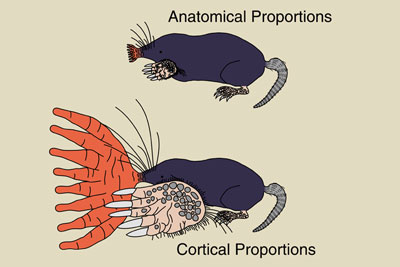Form and Function
 Condylura cristata
has evolved numerous characteristics that help it survive, but none
have been studied as extensively as the star-shaped nose, which its
common name (star-nosed mole) is based on. C. cristata lives primarily underground and, because
of this,
its sight has diminished through the generations. To combat this,
the star-nosed mole has evolved a
very sophisticated nose; its functions have been extensively studied
by many scientists. The nose has twenty-two appendages that form a
star shape at the nose (National Geographic 2010). Each of these
appendages is covered with thousands of receptors called Eimer’s
organs that act as feelers for C. cristata (Marasco and
Catania 2007). These feelers have allowed C. cristata to become one
of the most proficient hunters in North America. Because of the
numerous ultra-sensitive feelers the nose can detect the smallest
particles and prey (National geographic 2010).
Condylura cristata
has evolved numerous characteristics that help it survive, but none
have been studied as extensively as the star-shaped nose, which its
common name (star-nosed mole) is based on. C. cristata lives primarily underground and, because
of this,
its sight has diminished through the generations. To combat this,
the star-nosed mole has evolved a
very sophisticated nose; its functions have been extensively studied
by many scientists. The nose has twenty-two appendages that form a
star shape at the nose (National Geographic 2010). Each of these
appendages is covered with thousands of receptors called Eimer’s
organs that act as feelers for C. cristata (Marasco and
Catania 2007). These feelers have allowed C. cristata to become one
of the most proficient hunters in North America. Because of the
numerous ultra-sensitive feelers the nose can detect the smallest
particles and prey (National geographic 2010).
Further research into this fascinating nose has revealed that the
nose has even
 more functions than just
being a feeler. Scientists have
found evidence to
believe
that the star additionally serves as an electrosensory organ (Gould
et al. 1998). This means that C. cristata could use its
nose to detect prey without touching it. C. cristata’s nose
actually works as the eyes for this otherwise blind organism.
more functions than just
being a feeler. Scientists have
found evidence to
believe
that the star additionally serves as an electrosensory organ (Gould
et al. 1998). This means that C. cristata could use its
nose to detect prey without touching it. C. cristata’s nose
actually works as the eyes for this otherwise blind organism.
Another trait that C. cristata has evolved through time is
its oxygen storage capacity. C. cristata is a semi-aquatic
mammal so it needs the extra oxygen storage to sustain dives
underwater for as long as 47 seconds (McIntyre et al. 2002). When
tested, C. cristata’s lung capacity was measured to be 65.4%
higher than non-aquatic moles (McIntyre et al. 2002). This extra
lung capacity has allowed C. cristata to extend its hunting
grounds to damper environments where C. cristata’s main
food sources thrive.
